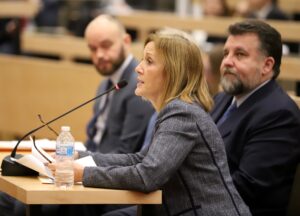
The tightening labor market is the "largest drag" on the state's economy, Eileen McAnneny (center) of the Mass. Taxpayers Foundation said Tuesday. UMass Dartmouth professor Michael Goodman (right) said the "biggest threat" is "our capacity to grow." Photo by Sam Doran | State House News Service.
With an aging workforce and a low unemployment rate, Massachusetts faces a tight labor market, creating a dynamic that could limit the state’s future economic growth.
That was one of the main messages economists delivered to lawmakers on Wednesday, at an annual Ways and Means Committee hearing that launches the state budget-writing process. Economists who testified projected a slower revenue growth rate than in the past two years, offering estimates that ranged from 0.8 percent to 3.5 percent.
As the hearing progressed, the number-crunching gave way to gave way to broader discussion about constraints on the labor force and potential policy responses. Experts pointed to housing affordability, congestion relief and education as possible keys to unlock untapped potential.
“The one recurring theme we heard over and over, that the greatest threat to future growth is demographics, an aging workforce and a workforce that does not have the numbers to sustain any more robust growth,” Senate Ways and Means Chairman Michael Rodrigues said after the hearing.
Revenue Commissioner Christopher Harding characterized the Massachusetts unemployment rate as “impressively low,” forecasting a rate of 2.8 percent this fiscal year, and said that job growth may come at a slower pace than it has in the past.
“This could drive up wages, this could do all kinds of things that have a direct impact on business here in the commonwealth, because there’s a limited talent pool in order to achieve the growth these businesses want to achieve,” Harding said, after Sen. Cindy Friedman asked if there was any cause for concern with such a low unemployment rate.
The state’s workforce talent pool is further constrained by demographic shifts. As the population gets older, people aged 65 and older – often more experienced and productive workers – will be leaving the workforce at an “accelerated pace,” while the number of people between the ages of 16 and 64 flattens out, according to the Massachusetts Taxpayers Foundation.
MTF President Eileen McAnneny called the tightening labor market the “largest drag” on the state’s economy.
McAnneny called it “critically important” for the state to figure out how to provide more affordable housing options to attract young workers.
“When we talk about demographics, you can’t have the conversation without mentioning the cost of housing,” she said. “As young people decide where to locate in this increasingly global and mobile world, the cost of housing really is an impediment.”
The median home sale price in Massachusetts over the first ten months of 2019 hit $400,000, according to The Warren Group, publisher of Banker & Tradesman. That’s up 3.9 percent over the same period in 2018.
Similarly, UMass Dartmouth professor Michael Goodman said the “biggest threat” to the trajectory of the state’s economy is “our capacity to grow.” Goodman, who said it took him two and a half hours to commute to the State House from his New Bedford home, said economic growth has been concentrated in the greater Boston area, but “stifling congestion” and a high cost of living leave the opportunities in that region out of reach to many Massachusetts residents.




 |
| 

